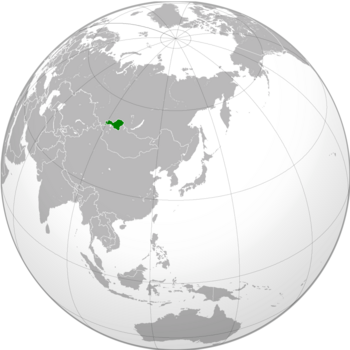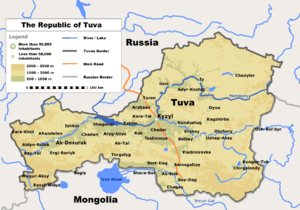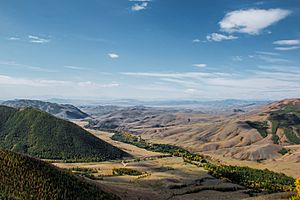Tuvan People's Republic facts for kids
Quick facts for kids
Tuvan People's Republic
Tьʙа Arat Respuʙlik
|
|||||||||||
|---|---|---|---|---|---|---|---|---|---|---|---|
| 1921–1944 | |||||||||||
|
Anthem: Tooruktug Dolgay Tangdym
|
|||||||||||

Tannu Tuva in 1936
|
|||||||||||
| Capital | Kyzyl 51°41′53″N 94°23′24″E / 51.698°N 94.390°E |
||||||||||
| Common languages | |||||||||||
| Religion | |||||||||||
| Government | Marxist-Leninist single-party socialist republic | ||||||||||
| Chairman | |||||||||||
| Prime Minister | |||||||||||
| Historical era | Interwar period, World War II | ||||||||||
|
• Independence proclaimed
|
14 August 1921 | ||||||||||
|
• Annexed
|
11 October 1944 | ||||||||||
| Area | |||||||||||
| 1944 | 170,500 km2 (65,800 sq mi) | ||||||||||
| Population | |||||||||||
|
• 1944
|
95,400 | ||||||||||
| Currency | Tuvan akşa | ||||||||||
|
|||||||||||
| Today part of | Mongolia Russia |
||||||||||
The Tuvan People's Republic was a country that existed from 1921 to 1944. It was located in Asia, between Russia and Mongolia. For some time, until 1926, it was also called the People's Republic Tannu-Tuva. This country was only officially recognized by two other nations: the USSR and Mongolia. Many people saw it as a "puppet state" of the USSR. This means it was technically independent but was heavily controlled by the Soviet Union. The main way people made a living there was by raising and selling cattle, as many were nomads. The capital city was Kyzyl. Today, this area is known as the Tuvan Republic and is a self-governing part of Russia.
Contents
What Was the Tuvan People's Republic?
The Tuvan People's Republic was a country that declared its independence in 1921. It was a socialist republic with a single-party government, meaning only one political party was allowed to rule. This type of government was inspired by the ideas of Marxist-Leninism, which focused on creating a society where everyone was equal.
Where Was Tuva Located?
The Tuvan People's Republic was situated in a unique spot in Central Asia. It was nestled between the large country of Russia (specifically its Siberian part) to the north and Mongolia to the south. This location meant it had strong ties and influences from both its powerful neighbors. The capital city, Kyzyl, was centrally located within the country.
How Did Tuva Become a Country?
Before becoming the Tuvan People's Republic, the area was part of the Russian Empire. After the Russian Revolution, different groups fought for control. On August 14, 1921, the Tuvan People's Republic officially declared its independence. This happened during a time known as the Interwar period, between World War I and World War II.
Who Were Its Leaders?
The country had a leader called the Chairman. One important leader was Khertek Anchimaa-Toka, who was the Chairman. The Prime Minister was Salchak Toka. These leaders played a key role in guiding the country during its existence.
What Was Life Like in Tuva?
Life in the Tuvan People's Republic was largely shaped by its geography and the traditions of its people. Many Tuvans were nomads, meaning they moved from place to place with their animals.
Daily Life and Economy
The economy of the Tuvan People's Republic was mostly based on nomadic people raising cattle. This included animals like sheep, goats, horses, and yaks. They would move their herds to find good pastures, which was a traditional way of life in the region. The money used in the country was called the Tuvan akşa. People also practiced different religions, including Tibetan Buddhism, Shamanism, and forms of Christianity like Old Believers and Eastern Orthodoxy.
How Did Tuva End?
The Tuvan People's Republic existed for 23 years. On October 11, 1944, during World War II, it became part of the Soviet Union. It was no longer an independent country but became the Tuvan Autonomous Oblast within the USSR. Today, this area is known as the Republic of Tuva and is a part of Russia.
Images for kids
See also
 In Spanish: República Popular de Tannu Tuvá para niños
In Spanish: República Popular de Tannu Tuvá para niños










